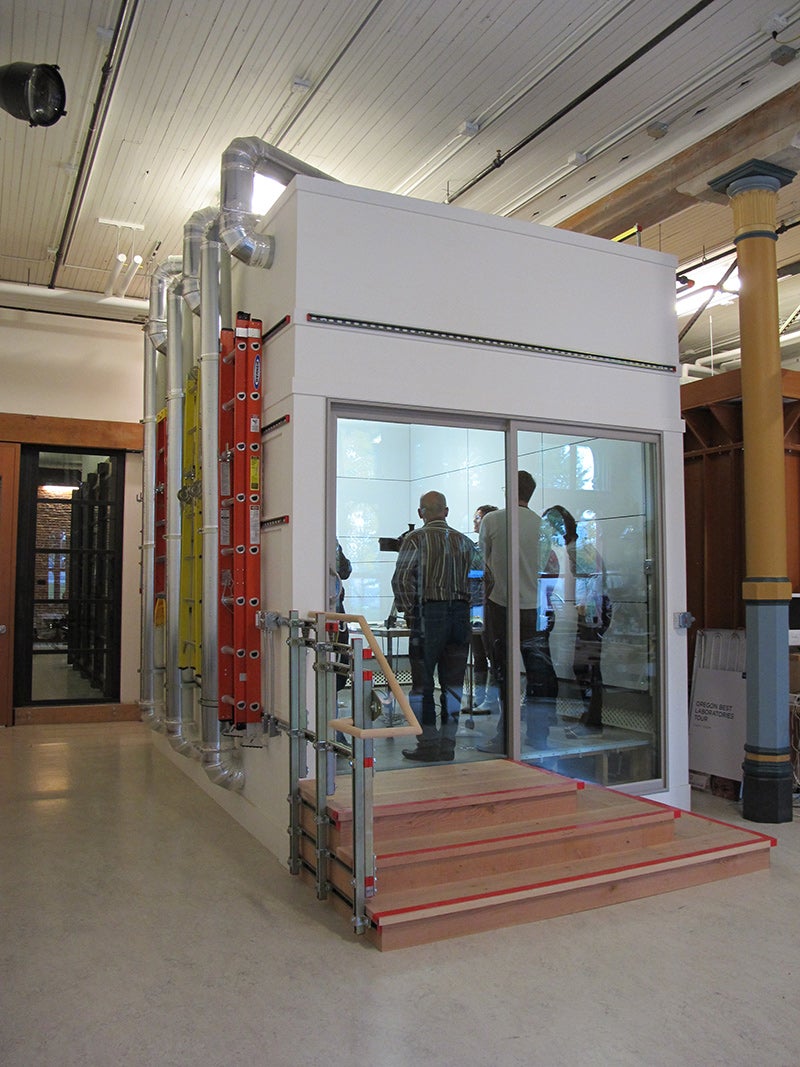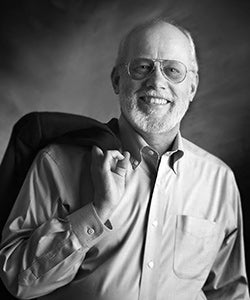When Jason Stenson drove up to a barn in Damascus, Oregon, four years ago, he knew what he hoped to find inside, but he never imagined it would become known as The Pickle Box.
Stenson is a research assistant who works with G.Z. "Charlie" Brown in the Energy Studies in Buildings Laboratory (ESBL) at the University of Oregon. The researchers needed a big box “with insulated walls, so we could heat it or cool it and keep it that way” while testing occupants’ comfort levels over a wide range of combinations, Brown says.
Inside the barn, Stenson was about to encounter the Pickle Box: a 10’ X 12’ X 10’ walk-in refrigerator, which he, Brown, and ESBL colleagues would eventually craft into a research tool now officially called the Climate Chamber.

Above: The climate chamber, a recycled walk-in cooler, is a "thermal comfort prototyping chamber" that simulates the interaction of a human user with temperature, relative humidity, air movement, and other variables for comfort evaluation. Photograph courtesy the Energy Studies in Buildings Laboratory (ESBL).
The chamber is a research device for architects, designers, engineers, utilities, and product manufacturers seeking detailed, quantifiable data on human comfort evaluation and product testing. It can simulate any building.
On May 29, the climate chamber will be open to the general public for the first time, from 4-7 p.m. at an open house at the UO in Portland’s White Stag Block, 70 N.W. Couch Street.
In addition to publicly debuting the climate chamber, the ESBL open house will offer tours and demonstrations of the lab’s other research instruments including the Heliodon, which simulates the sun to assess daylighting and shading strategies; and the Artificial Sky, which simulates an overcast sky to analyze daylighting strategies.
The climate chamber is the culmination of years of research effort.
"I had a vision of a climate chamber that I could take architects, engineers, and building owners and developers into,” says Brown, a professor in the UO Department of Architecture, “that would demonstrate that thermal comfort can be achieved with different variations in temperature, wind speed, radiant field, and relative humidity.” This was important because expanding the comfort zone reduces energy use, which was his objective.
The ESBL colleagues found the walk-in cooler through a newspaper ad. “It looked perfect to us,” Brown says of the giant refrigerator in a barn, “so we negotiated for it. After we got it loaded into a truck, we asked the woman selling it, ‘Why did you have this refrigerator in your barn?’ And she said, ‘Well that’s where I stored my pickles.’ Hence, the Pickle Box.”

Above: Professor G.Z. “Charlie” Brown
The Climate Chamber is a "thermal comfort prototyping chamber" that simulates the interaction of a human user with temperature, relative humidity, air movement, and other variables for comfort evaluation. The chamber works with adaptive controls to optimize and quantify energy use and user satisfaction.
“Surprisingly, people cannot tell what temperature it is. They are not thermometers, but they can tell whether they are comfortable or not," Brown says. “We want [open house] attendees to know that the ESBL is a resource with expertise and facilities to help architects and engineers create and develop high-performance buildings, including net-zero. The chamber is also available for product testing and demonstrations.”
The ESBL conducts research and design assistance to develop new materials, components, assemblies, and whole buildings with improved energy performance to transform the market.
Under Brown’s stewardship, the lab has secured more than $20 million in research funding and assisted in reducing energy consumption in millions of square feet of building space in over thirty years of operation. The ESBL is also a founder of the University of Oregon Biology and the Built Environment Center, funded by the Alfred P. Sloan Foundation, to investigate the interaction of buildings and microorganisms.
Along with researching thermal comfort, the climate chamber is also a "human microbial cloud analysis chamber" that allows for experiments of the microbiology of the built indoor environment. This enables evaluation of impacts on and design for human health by using a new metric: microbes. The chamber does this through passive and active air sampling, and dust and surface swab collection that can be processed with Metagenomics DNA sequencing techniques.
The climate chamber is funded by Oregon BEST, the Northwest Energy Efficiency Alliance (NEEA), and product suppliers Aero Tech and The Modern Fan Company.
ESBL is an Oregon BEST lab, and part of NEEA’s Integrated Design Laboratory network.
For more information about the open house or the ESBL, contact esbl@uoregon.edu.
